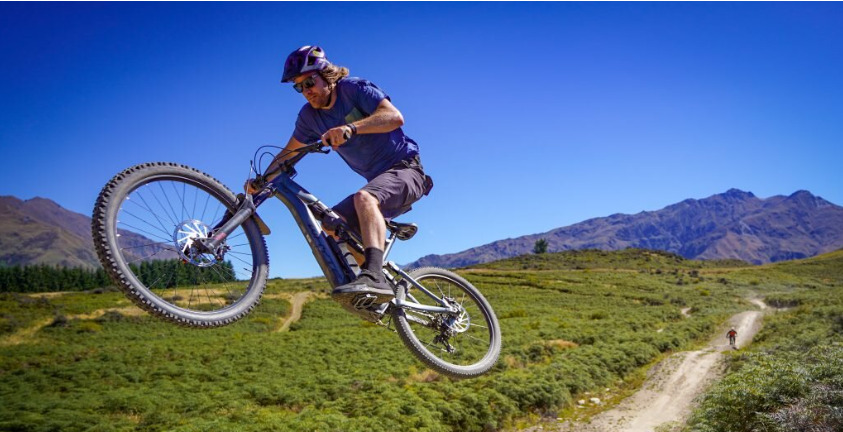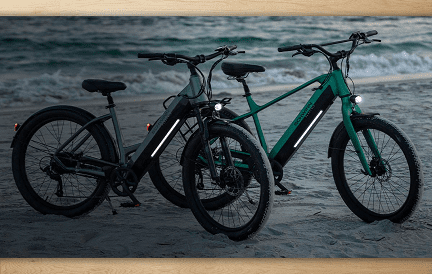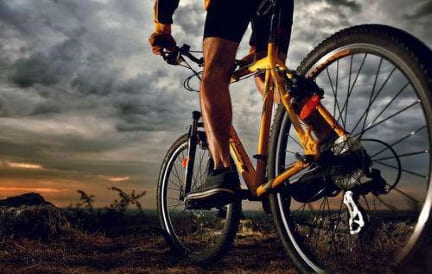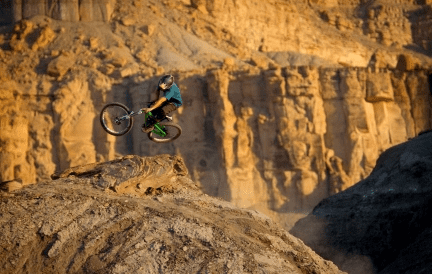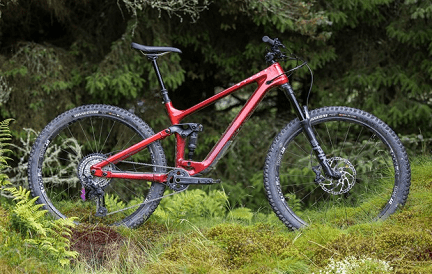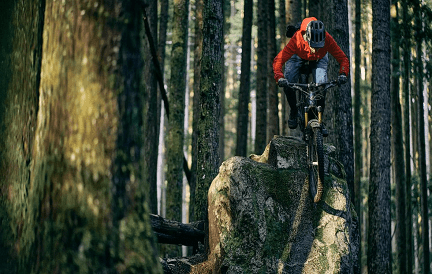What is a Hardtail Mountain Bike?
A hardtail mountain bike refers to a mountain bike with a front suspension fork but a rigid rear frame and no rear suspension. Hardtails have a distinct look with the front fork and provide some cushioning and shock absorption while maintaining excellent power transfer and pedaling efficiency. These bikes are lighter, more affordable, and lower maintenance than full suspension mountain bikes.
Hardtail mountain bikes utilize a frame constructed from materials like aluminum, steel, carbon fiber, or titanium. The front suspension fork provides anywhere from 80-120mm of travel to smooth out bumps and increase control in rough terrain. Hardtails rely on the frame and wheelset strength for absorbing impacts rather than rear suspension.
Compared to recreational mountain bikes, hardtail mountain bikes have more durable frames and components optimized for off-road handling. Popular wheel sizes for modern hardtails range from 27.5” to 29”. Hardtail mountain bikes MTBs make excellent multipurpose bikes and are ideal for cross country, trail riding, commuting, and other applications.
Advantages of Riding Hardtail Mountain Bikes
While full suspension mountain bikes provide maximum shock absorption, hardtail mountain bikes offer unique advantages that make them a popular choice for many riders:
Efficiency
The rigid rear triangle provides excellent power transfer when pedaling. There is no energy loss into rear suspension so more of your pedal stroke goes directly into forward motion. This makes accelerating and climbing on hardtail mountain bikes very responsive and efficient.
Affordability
Hardtail mountain bikes have simpler frame construction and fewer components than full suspension bikes. This makes them more affordable and economical for recreational riders or beginners not yet ready to invest in advanced full suspension bikes. Quality hardtails can be purchased for under $1000.
Low Maintenance
With no rear shock, pivot points, or bearings, hardtail frames are much lower maintenance than full suspension designs. Hardtail mountain bikes require only basic upkeep like chain lubrication and brake pad replacement.
Light Weight
The lack of rear suspension enables hardtail frames to be constructed from light yet strong materials like carbon fiber. Less weight makes hardtails easier to maneuver and economical pedaling performance.

Types and Models of Hardtail Mountain Bikes
Hardtail mountain bikes come in several main categories based on their intended riding purpose. The table below summarizes the key characteristics of each hardtail category:
| Category | Description | Fork Travel | Frame Geometry | Strengths | Example Models |
| Cross Country (XC) | Lightweight with swift acceleration for rolling terrain | 80-100mm | Steep head tube angle for nimble handling | Efficient pedaling, climbing | Trek SuperCaliber, Specialized Epic |
| Trail | Balanced hardtail for varioius mountain terrain | 120-140mm | Moderate head tube angle for versatility | All-around performance | Giant Fathom, Kona Big Honzo |
| Downhill | Burly construction for high speeds and big impacts | 160-180mm | Slack head tube for stability at speed | Maximum descent capability | Commencal Meta HT AM, NS Eccentric Cromo |
| Fat Bike | Oversized tires for traction in soft conditions | 100-150mm | Adjustable geometry to handle various surfaces | Floatation, winter riding, sand riding | Salsa Mukluk, Rocky Mountain Suzi Q |
Within each category, models differ based on:
Frame material – Steel, aluminum, carbon fiber, titanium
Wheel size – 27.5 vs 29 inch
Component specs – Groupset, brakes, drivetrain
Price range – Entry-level, intermediate, high-end

Choosing the Right Hardtail Mountain Bike
With an array of types and component specs available, keep these factors in mind when selecting the ideal hardtail MTB for your needs:
Suspension Fork
The front fork travel range will influence downhill stability and control. Cross country bikes need 80-100mm, trail 120-140mm, downhill 160-180mm. Lockout is useful for climbing efficiency.
Frame Material
Steel is durable and economical. Aluminum is affordable, lightweight, and absorbs vibration well. Carbon fiber is the premier material for performance, weight savings, and comfort.
Wheel/Tire Size
Larger 29” wheels roll over objects easier while 27.5” wheels accelerate faster. Plus-sized tires provide more traction and cushioning. Choose based on local trails.
Groupset
Components like derailleurs, cranks, cassette, and brakes. Shimano SLX or SRAM NX are good intermediate quality groupsets. Higher is lighter but more expensive.
Frame Geometry
The angles and dimensions of the frame determine maneuverability and stability. Understand your optimal reach, standover height, head tube angle, etc.
Hardtail Mountain Biking Techniques and Tips
While hardtail mountain bikes require more finesse than full suspension bikes, proper technique will have you railing trails in control. Here are key skills to focus on:
Weight Distribution
– Stay centered over the bike, distributing your weight evenly between wheels for maximum traction.
– Shift body weight rearward for descending and clearing obstacles.
Limb Management
– Use your arms and legs as shock absorbers when absorbing impacts. Maintain soft elbows and knees.
– Avoid sudden, jerky movements that shock the rear wheel. Pedal smoothly.
Line Choice
– Pick smooth lines that limit harsh impacts. Roll over obstacles when possible.
– Let the wheels conform to the terrain rather than fighting it.
Braking
– Use mostly front brake to initial scrub speed, then feather the rear brake.
– Avoid sudden grabs that lock up the wheels and cause instability.
Body English
– Stay loose and move with the bike. This allows the bike to track better through rough sections.
– Visualize balancing over the tires as they conform to the terrain.

Customization and Upgrades for Hardtail Mountain Bikes
One of the best parts of owning a hardtail mountain bike is the ability to customize and upgrade components over time. Hardtail MTBs provide an ideal platform for evolving an entry-level bike into your dream machine tailored to your riding style and local terrain.
Upgrading the suspension fork is an excellent first investment on a hardtail mountain bike, as it will significantly improve control and open up more technical downhill riding. A higher quality fork with more travel, adjustability, and premium construction can completely transform the downhill confidence of a hardtail MTB. Suddenly terrain that seemed untouchable becomes accessible.
Another popular upgrade for hardtail mountain bikes is the wheelset. High-engagement hubs and wider rims greatly improve the bike’s responsiveness and traction. The wheels have a huge impact on how snappy the hardtail feels when accelerating and cornering. Upgraded wheels also provide more compliance and comfort when tackling rugged terrain.
Other key upgrades that can maximize a hardtail’s capability include a dropper seat post for optimizing saddle height, more powerful brakes for control on steep trails, and cockpit upgrades like wider bars and grippier pedals for greater control.
Part of the fun of hardtail mountain bikes is gradually upgrading components to create your dream custom trail bike tailored exactly how you want it. The possibilities are endless!
The Thrill of Hardtail Mountain Biking
While full suspension bikes isolate the rider from the terrain, riding a hardtail directly connects you to the trail for an unfiltered mountain biking experience:
– The rigid frame provides a responsive feel where every bump and edge can be felt, forcing you to pick smart lines.
– Accelerating out of corners and up climbs feels lightning quick and efficient without rear suspension bob.
– Threading through tight singletrack and winding roots trains supreme bike handling skills.
– You take on each descent with intense focus to smooth out the bumps, letting your limbs absorb impacts.
– Clearing rugged rock gardens and technical obstacles on a hardtail provides a major thrill and sense of accomplishment.
– Floating over fast flow trails with the front end diving through turns brings endless smiles.
Maintenance and Care for Hardtail Mountain Bikes
While hardtail mountain bikes are lower maintenance than full suspension, some periodic upkeep will keep your bike performing optimally for years:
– Keep your chain clean, lubricated, and at optimal tension to minimize drivetrain wear.
– Inspect brake pads frequently and replace them once worn down to 2mm or less thickness. Keep rotors straight and clean.
– Check that all hardware and bolts are tightened securely so nothing comes loose while riding.
– Routinely inspect the tires for cuts or bulges, and ensure optimal air pressure before each ride.
– Service the suspension fork per manufacturer guidelines, changing oil, seals, bushings, and hardware as needed.
– Wipe down the frame, wheels, and components after muddy/dusty rides to prevent buildup and corrosion.
– Store your bike properly by gently cleaning it and avoiding direct sunlight, moisture, or temperature extremes.

Hardtail Mountain Bikes for Rough Terrain
While many hardtail mountain bikes are designed for general mountain biking, certain models are optimized for conquering the most rugged trails:
Downhill Race Hardtails
Beefy frames and 180mm forks take on bike park black diamonds and gnarly rock gardens. Top models include the Commencal Meta HT AM and NS Eccentric Cromo.
Steel Hardtails
Chromoly or Reynolds steel soaks up vibration better than stiff aluminum when plowing through rubble fields.
Plus Bikes
Oversize 2.8-3” tires provide more cushioning and traction over obstacles at low pressures. Examples include the Salsa Timberjack and Norco Torrent HT+.
Fat Bikes
Massive 3.8-5” tires allow riding over sand, snow, or any loose surface by floating on top. Try the Salsa Mukluk or Rocky Mountain Suzi Q.
FAQs about Hardtail Mountain Bikes
What’s the difference between a hardtail and full suspension bike?
Hardtails have front suspension only while full suspension bikes have front and rear shocks. Hardtails pedal more efficiently while full suspension smoothens rough descents.
What fork travel is ideal for a hardtail trail bike?
120-140mm is optimal for balancing climbing and descending capability for most trail riding. Shorter is lighter while longer enables faster downhill speeds.
How much more maintenance does a full suspension bike require compared to a hardtail?
Full suspension bikes require much more routine maintenance like rear shock rebuilds, pivot lubrication, and replacing bearings. Hardtail maintenance is simpler.
What’s the benefit of plus-sized tires on a hardtail?
Plus-sized tires 2.8” or wider provide more traction, comfort, and shock absorption at lower pressures. They make hardtails more capable over obstacles.
Can hardtail bikes be used for bike packing and bike touring?
Yes, hardtails work excellently for loaded multi-day adventures. The simple durable frames and easy maintenance are ideal for extended trips.


